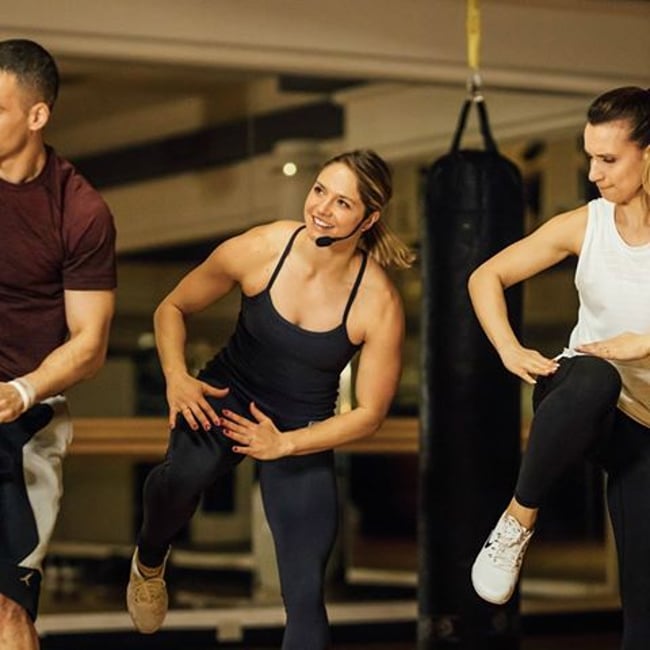In a Teaching Rut? Be a Participant!
You can gain a lot from attending another instructor’s class.

Many group fitness instructors depend on expensive subscriptions and certifications as their only resources for education. As the director of a large team (more than 100 instructors) for the past 9 years, I’ve learned that there’s significant educational value in attending others’ classes. Instructors who make the effort to try a new experience maintain passion, improve their own skills and eventually surpass instructors who’ve been teaching longer. What are the benefits of attending someone else’s class, and how do you make the most of your experience as a participant?
Reliving the Thrill
Do you remember your very first group fitness class? Were you nervous? Excited? Perhaps your years of teaching have made you a bit jaded, and you’ve forgotten the thrill of waiting for the first few beats of the playlist. Attending another instructor’s class gives you a unique educational opportunity.
When you teach, you give so much to your participants, and you are responsible for getting to know each person, providing effective exercises, playing good music and creating a memorable experience. You have to be “on.” When you attend a class, you can relax, be “off” and allow another hardworking instructor to teach an inspirational workout. Sure, it can be difficult to set aside time to do this, and it’s not as if we’ve even had the chance during the lockdown, but as facilities open up, I encourage you to plan ahead and attend another instructor’s class, whether at your gym, online or at another facility.
“If you teach a lot of cardio, I recommend attending mind-body classes so that you keep your body safe,” suggests ZUMBA® instructor Surabhi Chauhan. “Even though these are formats I don’t teach, I find value in attending them because I learn new cues and exercise combinations while also building relationships with the instructors and participants.”
A good rule of thumb is to attend a class at least once per quarter. Some fit pros do it frequently. Jessica Rodgers, a group fitness manager and instructor, recommends planning your teaching, subbing and attendance schedule a week or more in advance and choosing a variety of classes. “For example,” says Rodgers, “I’ll try to take a cycling class one day and yoga the next, or I’ll do a HIIT class next to a Pilates class so I’m not at risk of overdoing one format over another.”
See also: How to Become a Group Exercise Instructor
Intentional Participation

Take it in and understand the member experience for yourself.
Here are some tips to help you get the most out of attending another instructor’s class:
Plan ahead. With apps like ClassPass and Mindbody, it’s easy to research studios and instructors—and even easier to try out new classes (sometimes for free) by reserving classes in advance. All the new virtual options make it even simpler!
Make it convenient. Find a class that works with your schedule. You don’t have to take the same type of class that you teach—try something new! And don’t forget to add the class to your calendar. Account for travel and check-in time if it’s your first time, and make sure in advance that the facility is open.
Ask questions and be outgoing. Arrive early so that you can meet the most dedicated participants and, if given the chance, ask them one or all of these questions:
- How long have you been taking this class and why?
- What do you enjoy most about the instructor?
- How has taking this class helped you reach your fitness goals?
Adia Callahan, a group fitness instructor and WIFA (womeninfitness.org) ambassador, shares what she pays attention to when participating in other classes: “I take in and understand the member experience for myself. I . . . learn from classes where the instructor has energy and brings that out of the members. I pay attention to cuing, both the words chosen and the timing, and to how the instructor is utilizing music, especially in conjunction with the exercises. Exercise ideas are a bonus, but the experience is more valuable to me.”
“I pay special attention to the vibe,” says Nichole Arthur, a cycling and TRX® instructor. “I notice if the instructor offers a brief explanation of what to expect, how the instructor’s energy and voice guide the intensity, and if the instructor makes eye contact. I also try to take note of why and how the participants are interacting or not interacting with each other. When it comes to music selection, I’ve learned the most about music timing by taking other classes. When the music doesn’t match the intensity, it can make the class feel like it takes an eternity.”
Bring a notebook. Don’t just write down your favorite cues or phrases; also note the key segments of the class experience (see the sidebar, left) and compare them to how you organize your classes.
Be open-minded. As mentioned earlier, trying other formats can be a great way to protect your body from overuse. Also, when you are attending an unfamiliar class, it may be easier for you to focus more on the value of the experience rather than on the exercises per se.
Rodgers recalls a negative experience that helped her learn a lesson. “I don’t teach yoga, but while I was taking a yoga class, the instructor told us how not to stand: “Don’t stand with your feet like this; don’t stand with your arms here,” etc., but she never actually told us how to stand. While the experience may not have been ideal, in the role of participant I could understand more clearly why it’s important to avoid negativity.” As a result, Rodgers says, her own cuing became more “clear, concise and positive,” to ensure that participants would fully understand what they should be doing.
Expand Your Education
Another benefit to keep in mind is that attending other classes within your own facility adds value to your company’s success. “I try to attend different barre classes [at the facility where] I teach,” says Chauhan. Her own class size is still small, and being seen in other classes helps her gain presence. “I am also able to observe what other instructors are teaching, and that helps me learn.”
Don’t limit yourself to CEC credits and certifications as the only ways to maintain your education. Get off the stage and back to the front row. Support your fellow fitness instructors while learning and growing yourself!
See also: How Constructive Criticism Makes You a Better Instructor
Key Segments of Class Experience
To get the most from your experience, note the following when you take another instructor’s class.
Feel:
- Pay attention to how you felt as a new participant. Did you feel welcome, or did you feel that everyone else knew something you didn’t?
- When the instructor transitioned from warm–up to workout, did your body feel ready?
- Did the movements match the muscles you were being asked to feel?
- When the instructor told you to push yourself more, was it clear for how long and how many times?
Hear:
- Did the instructor say or include anything in the introduction that made you feel prepared and welcomed as a new participant?
- What were some of the cues that motivated you or helped to improve your form? How can you implement those in your own class?
- How did the instructor creatively use imagery?
Connect:
- How did the instructor connect with participants?
- Did the instructor know or say any participant names out loud?
- When you arrived, did you feel like the instructor fostered community and positivity?
- Did the instructor make eye contact with you? How did that make you feel?
- Did the instructor face the students and move around the room to be closer to every participant? Or help people in the back and along the sides of the room to see or understand the exercises better?
Experience:
- Did all of the exercise choices serve a purpose?
- Were the moves safe, and was there a logical flow?
- Did each part of the experience—beginning, middle and end—feel well-planned and executed?
Recall:
Later that day or week, think back to the class. What do you remember most? Relate this to
what your participants may be remembering about your classes.
More Lessons Learned From Taking Classes
Instructors are often pleasantly surprised by what they learn from taking someone else’s class. Adia Callahan, a group fitness instructor and WIFA ambassador, learned a new skill while recovering from a personal injury. “I took a unique strength class that I was nervous about,” says Callahan. “The way the instructor layered the modifications was impressive and such a great experience. I made it a goal to improve [that] in my own teaching. I’ve taken classes where I could handle the exercises, but the instructor wasn’t [paying attention to] the other participants’ ability levels. Not feeling successful as a participant is a very bad experience. The layering technique I took from this experience has helped me prevent that feeling in my own classes.”
Nichole Arthur, a cycling and TRX® instructor, picked up a new way to welcome class members. “I attended a class, and the instructor said: ‘Don’t do it if it doesn’t feel good. Take a break when you need to. If you’re feeling good, I want you to push yourself, and—most importantly—I want you to have fun!’ It was the best opener I had ever heard! I think hearing it as a participant resonated with me more, because right away it made me feel at ease and comfortable bringing my best self. It was like the instructor was giving me permission to just enjoy the class. I always try to include this in my introduction/warmup.”
Staci Alden
Staci Alden is committed to helping group fitness managers elevate their programs, instructors, and leadership skills through her writing, presentations, and YouTube channel. For more than a decade, she has overseen a team of over 100 private Pilates and group fitness instructors at a luxury health club in Seattle, Washington. Staci also is certified as a master Balanced Body® barre and MOTR® instructor.






